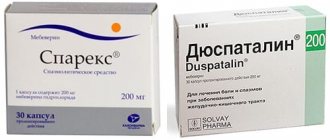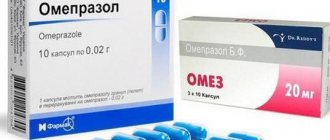List of drugs used
The use of antibiotics for pancreatitis serves to prevent possible complications in cases of threatening symptoms.
The expected result can be achieved with timely initiation of treatment, since during the missed period significant changes, often irreversible, can occur in the body. The acute nature of pancreatitis is more demanding for therapeutic treatment with antibiotics, since in this case it is necessary to stop the development of the disease as soon as possible and try to eliminate it. In the chronic form, with relapses occurring from time to time, as a rule, patients need less antibiotics.
The main indication for prescribing drugs with antibacterial properties are signs of peripancreatitis, a condition in which inflammation from the pancreas begins to spread to nearby tissues and to the mucous membrane of the gallbladder located nearby. In the current situation, delay is unacceptable and penicillin medications and cephalosporins are prescribed as emergency measures.
If there is inflammation in the pancreas, doctors recommend antibiotics, but only if there are reasonable indications for this. These drugs may be:
- Amoxiclav;
- Biseptol;
- Abaktal;
- Amoxicillin;
- Bactrim;
- Vancocin;
- Tienam;
- Tsiprolet and others.
For pancreatitis that requires immediate action, specialists usually use Ceftriaxone and one of the drugs with a wide range of actions in the form of De-Nol, Kvamatel, Omez, Cerucal, Ultrop. In a number of situations, Atropine is prescribed; when prescribed, the tablet form is advantageous.
Fibrinolysis inhibitors - drugs used to treat pancreatitis
This pharmacological group has a number of representatives, the most effective of which is Contrikal. In addition to inhibiting fibrinolysis, this drug has an antiproteolytic effect, that is, it blocks the synthesis of proteinases in the pancreas. This leads to the fact that autolytic processes and “self-digestion” of pancreatic tissue stop and regenerative processes begin. Thus, “Kontrikal” inhibits the action of trypsin, chymotrypsin, kallikrein and plasmin.
- "Contrical" is contraindicated during the lactation period, as well as in pregnant women in the first trimester. It can be used both for acute and exacerbation of chronic pancreatitis, and for the prevention of the development of postoperative pancreatitis in the case of surgical interventions on the pancreas and abdominal organs (cholecystectomy, gastrectomy, papillosphinketrotomy).
It is used parenterally (intravenously) at 250,000 antitrypsin units, very slowly, and then during the day an additional administration of 250,000 is indicated slowly over 24 hours. To prevent postoperative pancreatitis, 200,000 antitrypsin units are administered slowly intravenously over 24 hours.
What antibiotics can be used for pancreatitis?
For pancreatitis and cholecystitis, the following antibiotics are prescribed:
- Cefotaxime;
- Ceftriaxone;
- Biseptol;
- Sigmamycin;
- Amoxiclav;
- Bactrim;
- Metronidazole;
- Abaktal;
- Tienam;
- Vancocin;
- Amoxicillin
- Kanamycin
- Tsiprolet.
Additionally, drugs with a wide spectrum of effects are prescribed:
- De-Nol;
- Kvamatel;
- Cerucal;
- Omez;
- Ultop.
In some cases, the patient may be prescribed Atropine. The predominant dosage form of such drugs is in the form of tablets.
Today we are faced with a wide variety of effective antibacterial agents. But how do you know that this particular drug will help with the infectious complication of pancreatitis? Moreover, in a situation where this pathology is not indicated in the instructions for use of the medicine.
If you carefully read the annotations for many antibacterial drugs, you will notice that such an indication for use as pancreatitis, unlike cholecystitis, does not appear there, which is why we can conclude that for pancreatitis, antibiotics should not be used at all. Actually this is not true.
You need to understand that antibiotics for inflammation of the pancreas are a secondary medicine; the appropriateness of their use is called into question in many cases, so drug manufacturers do not consider it necessary to focus on such use of an antimicrobial drug.
But sometimes you just can’t do without antibiotics. To say that specific drugs somehow stand out among others in the treatment of pancreatitis would be incorrect. After all, it’s not even a matter of the name of the drug, but what pathogenic microorganisms are sensitive to it. The same drug can help one patient and not improve the condition of another, if we are talking about a strain of bacteria that is insensitive to the drug. Therefore, in each specific case an individual approach to the selection of effective drugs is needed.
It is easier if a sensitivity test is performed, but this is not always possible. In most cases, you have to act by trial and error, based on knowledge of the most likely causative agents of pancreatitis.
Most often, bacterial pancreatitis and complications of non-bacterial inflammation are caused by: Escherichia coli, Proteus, Clostridia, i.e. anaerobic representatives of pathogenic microflora that live in the intestines, but do not miss the opportunity to travel throughout the body. Treating such an infection is quite difficult, but it spreads very actively inside the body.
Inflammation can also be provoked or intensified by opportunistic microorganisms (streptococci, staphylococci, etc.), which usually happens in the chronic course of the disease against the background of reduced immunity. But even in this case, without test results, the presence of other bacteria, for example, the same anaerobes, cannot be ruled out.
All these points must be taken into account when selecting effective drugs. A broad-spectrum drug should cover the entire spectrum of possible pathogens of inflammation in the pancreas.
Many penicillins meet these requirements: “Penicillin”, “Ampicillin”, “Amoxicillin”, “Benzylpenicillin sodium salt”, etc. But the problem is that many bacteria have learned to synthesize a special enzyme, beta-lactamase, which negates the effect of the antibiotic. Therefore, doctors give preference to later generations of penicillin drugs that are resistant to the enzyme due to an additional component (most often clavuonic acid), in particular the drugs: Amoxiclav, Augmentin, Ampiox and others.
Among the cephalosporin drugs, the following are very popular: Cephalexin, Ceftriaxone, Cefutaxime, Gepacef, etc. Although these drugs also remain inactive against many strains of bacteria that produce enzymes that inactivate them, most of these drugs can be administered intramuscularly or intravenously, which gives better and faster results.
Macrolides also have a similar spectrum of action. These drugs, according to experts, cause the least amount of side effects. In addition, they are active even against those bacteria that are “armed” against penicillins and cephalosporins.
The drugs “Erythromycin”, “Azithromycin”, “Oleandomycin”, “Summamed” and other macrolides are prescribed for intolerance to penicillin and cephalosporin drugs, which is not a rare occurrence.
With an exacerbation of chronic pancreatitis, which in most cases is caused by opportunistic microflora, doctors may prescribe tetracycline antibiotics. The most commonly used drug is Doxycycline, which is characterized by a pronounced bacteriostatic effect (it does not kill bacteria, but does not allow them to multiply) and is effective against most cocci, as well as E. coli, chlamydia, clostridia and other pathogenic microflora. Alas, Proteus and Pseudomonas aeruginosa remain resistant to this drug.
For mild infections, some doctors prefer to use new types of antibiotics, for example, the drug Rifampicin, which will also prevent the infection from multiplying, and in large doses will show a noticeable bactericidal effect against many cocci, Escherichia coli, as well as some varieties of Clostridia and Proteus.
In severe cases of purulent inflammation, doctors prescribe stronger drugs from the group of fluoroquinolones. The most effective drug for treating severe complications of acute pancreatitis is Abaktal, the active ingredient of which is pefloxacin (2nd generation of fluoroquinolones). Pefloxacin has a pronounced bactericidal effect (inhibits the process of cell division and the synthesis of protein necessary for the construction of the bacterial membrane) and acts even on those bacteria that other antimicrobial agents cannot cope with.
[7], [8], [9], [10], [11]
Which ones are better
For pancreatitis, antibiotics are necessary in any case.
The patient is prescribed penicillin drugs: Augmentin, Ampicillin, drugs from a number of cephalosporins. Metronidazole can be used as an adjuvant antibiotic.
Carbapenem drugs (such as Tienam or Meropenem) are more expensive, but they are highly effective. The doctor determines the course of treatment based on the patient's current condition. The following complications are taken into account:
- bacterial complication (pancreatic necrosis, cholangitis);
- the threat of bacterial infection entering the abdominal cavity and the development of sepsis;
- ruptures of the gland duct;
- stagnation of bile.
If the patient is insensitive to chlamydia, then he is prescribed Sumamed or Abaktal.
Average prices
The average price of antibiotics may differ depending on the type of drug. The difference in price is also affected by the location of the pharmacy, since in the capital the same drug will cost more than in smaller cities.
When purchasing, you should consider the following circumstances. The fact is that the same drug belonging to the same general group may have different names and differ in price. These differences primarily depend on the country where the medicine is produced and the company where it is directly manufactured. Differences in price arise due to the fact that original drugs are several times more expensive than generics, although the active substance in them is the same. Moreover, this does not mean that a copy of a branded drug will be much weaker in effectiveness.
For comparison, you can look at the existing differences in the price of the drug, which is often prescribed for pancreatitis:
- Pancreatin in Russia can be purchased at a price starting from 30 rubles for one package of 60 tablets;
- Mezim Forte (the same pancreatin, but under a different brand) will cost an average of 245 rubles for 80 tablets.
In general, drugs in the form of antibiotics are quite accessible and inexpensive, their price depends on the type of drug, since in case of severe exacerbation it is necessary to use the latest generation of antibiotics, their average price will be slightly higher than others. If the prescription is made simply to eliminate the symptoms of inflammation, then they turn to simpler drugs, which will not cost much.
Basic rules for taking antibiotics
The effectiveness of treatment for pancreatitis in adults depends on how well the patient takes medications correctly. This is especially true in cases where the disease is severe, and this can happen in about 1/5 of patients.
When treating with antibacterial agents, you must follow the following rules:
- Drugs are prescribed only by a doctor based on a thorough preliminary diagnosis.
- Potent antibiotics are prescribed only when traditional remedies fail.
- For chronic pancreatitis, all medications are administered to the body intravenously or intramuscularly. When taken orally, part of the active substance is deactivated in the intestines, and the effect will be much less.
- Injections can be prescribed up to 3 times a day, and the total duration of the course can be 10 days or more. Treatment of the advanced chronic form requires long-term therapy. Even after stopping the medication, the patient may have residual effects, and these often continue throughout life. Therefore, only a doctor can determine the duration of therapy for each patient.
The rules described below will help prevent complications and relieve symptoms of pancreatitis.
- The maximum effect is achieved by intramuscular or intravenous administration.
- Follow the dosage strictly prescribed by your doctor.
- Do not take for more than 14 days.
- Take the tablets with still water.
- Maintain intervals between doses.
As soon as you notice the first improvements, you should not suddenly stop drinking them. Withdrawal of the drug must follow a schedule, otherwise you will not achieve a positive result.
Possible development of intoxication with an antimicrobial drug. Therefore, taking medications has certain rules
In conclusion, it should be noted that the list of antibiotics that can be taken for pancreatitis is large; we have listed only the most effective ones. But, you should not self-medicate, this will worsen the general condition or complications may arise.
Directions for use and doses
For pancreatitis, Metronidazole tablets are taken orally, without chewing, during or after meals, with a sufficient amount of clean water (or milk). It is well absorbed and begins to act quickly. The daily dose of Metronidazole is 1500 mg (divided into 3 doses), the maximum is 2000 mg. The treatment regimen for pancreatitis is selected by the doctor in each case individually, depending on the course of the disease and associated complications. Changing prescriptions on your own can be harmful to your health.
Instructions for use
Frequent use of antibiotics is undesirable due to the fact that then pathogenic microorganisms become accustomed to the drugs used. With uncontrolled and indiscriminate use of antimicrobial drugs, eliminating the symptoms of pancreatitis will take a long time and not always successfully. Therefore, taking medications in the form of antibiotics should only be started as prescribed by a specialist and strictly following his recommendations.
It is strictly prohibited to carry out antibiotic therapy on your own, since this can worsen the condition of the diseased organ and the disease will remind itself of itself with frequent relapses. Such actions can cause long-term serious consequences, which can occur in the form of malignant degeneration of the pancreas or diabetes mellitus.
Carrying out therapy using potent antibiotics requires adherence to the instructions for use of this type of medicine, namely:
- It is more effective to administer the drug via intravenous or intramuscular injection;
- Therapy lasts from a week to two; longer use of antibiotics is not recommended;
- Antibiotic tablets are washed down only with plain still water;
- It is not allowed to independently adjust the prescribed dose of the drug;
- If there is no improvement in well-being when using the medication within three days, it is recommended to reconsider the prescription, since this most often indicates that the microbes are not susceptible to the antibiotic;
- The treatment course must be completed in full; premature termination due to improvement in well-being is not allowed;
- To consolidate the positive results of treatment, taking the medications continues for about two more days;
- The drugs must be taken at strictly defined times, at regular intervals - during treatment, a constant concentration of the drug must be maintained.
It is especially important to keep patients’ condition under control and monitor the correct treatment with drugs for pancreatitis, since this disease leads to severe complications in almost every fifth case.
Therefore, it is so important in this situation to follow the rules of treatment with antibacterial agents:
- Antibiotics are prescribed for pancreatitis only in cases of particularly severe exacerbations, that is, when standard therapy does not bring relief.
- Before prescribing antibiotics, it is necessary to conduct a complete examination of the patient; this is necessary for the drug to bring positive dynamics in treatment.
- To get quick results, it is recommended to receive antibiotics by injection.
- It is important to strictly follow the prescribed course and complete it completely; if a course of ten days is prescribed, then the treatment should last exactly that long, no more, but no less.
Treatment of pancreatitis can take a long time, so you should not hope that the result will be obtained quickly and the symptoms of the disease will disappear forever. Even after a seemingly complete cure, the risk of exacerbation remains forever.
Features of therapy
Treatment of pancreatitis with antibiotics occurs according to an individual scheme for each patient. The use of antibacterial drugs should be combined with enzyme agents (Festal, Pancreatin, Mezim) and antispasmodics (No-Shpa). The latter help relieve spasms of the intestinal tract and reduce the intensity of pain.
If the patient has an inflamed gallbladder, he may be additionally prescribed drugs to stabilize the liver and the outflow of bile. Alcohol, spicy, salty and smoked foods must be excluded.
In case of an acute attack of the disease, therapeutic fasting is recommended for 2-3 days. During this time, the patient can only drink water in an amount of at least 2 liters per day.
Taking No-shpa will help relieve spasms of the intestinal tract and reduce the intensity of pain.
In case of secondary disorders in the gastrointestinal tract, the development of shortness of breath, the gastroenterologist and therapist prescribe antibacterial drugs that destroy pathogenic microbes not only in the pancreas, but also in the stomach and intestines. If the body is insensitive to bacteria, therapy can be adjusted.
If it is necessary to treat recurrent pancreatitis and cholecystitis, then the therapeutic regimen is selected individually in each case. The disease can last a long time, so it is extremely important to choose the most effective drug so that it can overcome the disease. Combined administration of antibiotics is indicated: one drug is administered to the patient intramuscularly or intravenously, and the other orally. This technique is effective for particularly severe forms of pathology.
If a patient is prescribed such medications for a long time, then he is advised to take probiotics.
To restore the natural intestinal microflora, Linex is prescribed.
These are drugs that restore the natural intestinal microflora. The most effective medications from this group are Linex, Bifiform. The course of taking probiotics is up to 20 days.
Antibiotics are strong drugs that help cope with inflammatory processes occurring in the gland tissue. There are times when they don't help. This means that processes continue to occur in the gland that affect the tissue of the organ. This problem is solved with the help of surgery.
This negatively affects the health of the organ affected by the disease. All people who have at least once experienced an attack of pancreatitis should beware of alcoholic drinks and spices. The most severe complication of this disease is peritonitis and sepsis.
Recent clinical studies suggest that the human body can become accustomed to the action of certain groups of antibiotics. Then, even with adequate treatment, the active substances contained in the tablets will no longer be able to counteract the bacteria, and the infection will develop more intensely.
The prophylactic use of these drugs and their self-prescription is strictly prohibited. This inhibits the production of enzymes and weakens the human immune system.
The prophylactic use of antibiotics and their self-prescription are strictly prohibited.
Side effects from taking antibiotics:
- disturbance of the intestinal microflora, which is manifested by nausea, vomiting, diarrhea;
- blood disorders: anemia, leukopenia, thrombocytopenia;
- damage to the liver and kidneys (if a person has pathologies of these organs, then any antibacterial drugs are prescribed carefully);
- allergic reactions (urticaria, anaphylactic shock);
- candidiasis (candidiasis of the mouth occurs especially often, and in women - of the vagina);
- nerve damage (the most neurotoxic drugs are aminoglycosides and tetracycline);
- hemolytic anemia (due to the effects of antibiotics, blood cells begin to destroy, and the bone marrow cannot produce them due to toxic damage);
- the appearance of suppuration at the site of antibiotic administration.
Side effects
The medicine has side effects:
- from the gastrointestinal tract: nausea, vomiting, digestive disorders;
- from the central nervous system: tinnitus, insomnia, headache, fainting, confusion, problems with coordination of movements, which can have a negative impact on driving;
- from the urinary system: darkening of urine, dysuria, cystitis.
Other reactions: itching, skin hyperemia and other allergic manifestations.
Contraindications
When there is inflammation in the pancreas, it is important to pay close attention to the general condition of the patient, since existing chronic diseases resulting from pancreatitis can negatively affect the effectiveness of the treatment received. Thus, the following conditions may serve as contraindications that make the use of antibiotics undesirable:
- Having HIV;
- State of pregnancy and breastfeeding period;
- Severe liver dysfunction;
- Individual intolerance to antibacterial drugs;
- State of renal failure.
During treatment, complete abstinence from drinking alcohol is necessary, if this has not been done before. As you know, pancreatitis and alcohol are mutually exclusive concepts, and if the patient is interested in recovery, then he immediately refuses alcohol. If the patient has a tendency to allergic reactions and has previously had a sharp reaction to any drug, you must inform your doctor about this.
Interaction with other drugs
If compatible with alcohol or drugs containing alcohol, severe poisoning of the body may occur. To avoid an antabuse reaction, you should avoid alcoholic beverages during treatment.
Reduce the concentration of the drug:
- anticonvulsants;
- Rifampicin.
In combination with Disulfiram, there is a risk of developing confusion and other psychotic episodes that disappear after stopping this drug. Metronidazole doubles the concentration of Busulfan.
Reviews
Reviews indicate that if all the doctor’s instructions are followed, recovery is observed:
- Irina, 29 years old, St. Petersburg: “Acute pancreatitis developed, and upon analysis it was discovered that it was bacterial in nature. The doctor prescribed a course of antibiotics, and after it, my health condition stabilized.”
- Sergey, 42 years old, Saratov: “Ceftriaxone caused an allergic reaction, and the doctor decided to change the therapeutic course. Antibiotics prescribed according to an individual regimen helped get rid of pancreatitis, with no side effects observed.”
- Svetlana, 36 years old, Omsk: “With the help of tablets we managed to cure chronic pancreatitis. True, the course of therapy was long, but I carefully followed the instructions for using each drug, and the disease subsided.”
Dear readers, your opinion is very important to us - therefore, we will be happy to provide feedback on antibiotics for pancreatitis in the comments, this will also be useful to other users of the site.
As an experienced doctor, I know well and have observed in practice the condition of patients with pancreatitis many times. In many cases, it was possible to alleviate their plight only with the help of antibiotics, especially in cases where the disease is advanced and the pancreas itself is in terrible condition.
I agree that taking antibiotics plays a decisive role in the treatment of severe cases of the disease. In this condition, patients often have nothing else left, only after strong antibiotics they have to restore the normal microflora for a long time, but here the doctor and the patient retain the right to choose.
What methods will be used to maintain the body must be decided together. and in the middle of the day it allows. As he says, for the appetite. As a result, he began to experience abdominal pain, sometimes he feels nauseous, and when he presses on the pancreas area, he feels pain. Is it really impossible to cure, and he doesn’t even want to hear about stopping drinking.
Antibiotics for pancreatitis in a child
Adult patients can use any prescribed medications for treatment, provided there are no contraindications to them. Children should be treated with greater caution when prescribing, since not all groups of antibiotics can be used in childhood. So:
- Drugs from the group of fluoroquinolones can inhibit bone development and stop their growth.
- Cephalosporins harm children's livers.
Also, children are not prescribed drugs in the form of Amikacil, Netilmicin, Cephalexin, Ampicillin and Amoxicillin, since their use does not provide the necessary therapeutic effect due to the low concentration in the tissues of the gland.
Pregnancy and lactation
The drug should be used with caution in the second and third trimesters of pregnancy. You should not take the medicine while breastfeeding, because the main active ingredient passes into the milk. If there is an urgent need to use Metronidazole during breastfeeding, lactation should be stopped.
The drug should be used with caution in the second and third trimesters of pregnancy.
When are antibiotics prescribed?
For an inflamed pancreas, complex treatment includes taking antispasmodic, enzymatic and antibacterial drugs. In addition, it is necessary to strictly adhere to the diet.
In chronic pancreatitis, in case of relapse (re-development or worsening) of the disease, the course of treatment with antibiotics is selected individually for each patient.
If at this stage of treatment the disease progresses, then antibiotics are prescribed. As a rule, a course of 5-7 days is prescribed, it all depends on the severity of the disease and the general condition of the patient.
In severe cases, antibiotics are prescribed for pancreatitis in adults with a combined spectrum of action. Antibacterial drugs are prescribed in combination.
At the final stage after the main treatment, the patient must undergo a course of probiotics. Such remedies will help restore the intestinal microflora.
For pancreatitis in adults, antibiotics may be prescribed in tablet form.
When taking a pill, there is no need for the participation of qualified nurses, as with intravenous injections, for example.
What can be prescribed to the patient:
- Azithromycin: belongs to the group of semisynthetic antibiotics. The active ingredient is azithromycin dihydrate. The drug has a fairly strong antimicrobial and bacteriostatic spectrum of action. Due to the strong active component, the medicine quickly suppresses protein synthesis directly from the microbial cell. For pancreatitis, the dosage is 1 tablet, taken morning and evening after the main meal. The course of treatment lasts from 7 to 10 days; if necessary, a longer dose is prescribed.
- Abactal is an antimicrobial drug. The active component pefloxacin mesylate is capable of inhibiting the enzyme DNA gyrase, thereby disrupting the replication of bacteria that cause the disease. Take with meals, the average daily dosage is 800 mg.
- Amoxiclav, the drug has two active substances - amoxicillin, which is presented in the form of a trihydrate, and clavulanic acid. The dosage of tablets is selected individually (standard dosage regimen: for acute pancreatitis, 250 mg is prescribed, for chronic pancreatitis, 125 mg).
Each listed antibiotic for pancreatitis has its own contraindications, including side effects. Therefore, before using antibiotics for inflammation of the pancreas, it is imperative to consult with your doctor.
Antibiotics in tablet form are not always prescribed for inflammation of the pancreas. Doctors often prescribe a short course of injections.
It is not recommended to take antibiotics for the treatment of pancreatitis on a self-prescribed basis, as this can significantly aggravate the further progression of the disease.
The drug Cefotaxime has proven itself well and is only available with a prescription. The drug belongs to the third generation antibiotics and has an antimicrobial effect. The maximum concentration of substances in the blood plasma is observed half an hour after administration of the drug. Unlike other antibiotics, the bactericidal concentration of Cefotaxime in the patient’s blood can persist for 12 hours. It is excreted approximately 30% unchanged in the urine, about 20% in the form of active metabolites.
Dosage: 2 ml of Cefotaxime are prescribed (the drug is diluted with saline in a ratio of 1/4). To achieve a better result, you can dilute the drug with 1% lidocaine.
The second no less effective drug is Doxycycline. A semisynthetic antibiotic that belongs to the tetracycline group. It has a pronounced bacteriostatic spectrum of action, so the active components of the drug quickly inhibit the protein synthesis of pathogenic microorganisms.
When taken orally, Doxycycline is almost completely absorbed from the gastrointestinal tract. The course of treatment lasts for 5-7 days, the dosage of the drug and the number of infections are selected individually.
Often, for pancreatitis, doctors prescribe Ceftriaxone to patients. The drug belongs to the class of cephalosporins, therefore it has a strong bactericidal spectrum.
Dosage: 1-2 grams are administered intramuscularly every day. If the clinical picture of pancreatitis is pronounced, then 0.5-1 grams is prescribed every 12 hours.
For the most part, with timely diagnosis, standard methods of treating pancreatitis bring positive results. In those situations in which conventional therapy has not helped, treatment is carried out with antibiotics to free the pancreas from pathogenic microflora.
Antibiotics are also used for existing serious complications of pancreatitis. Thus, with the acute nature of the disease, its characteristic symptoms are stagnation of enzymes produced and swelling of the organ itself. As a result, fluid from active substances formed during inflammation accumulates in the pancreas itself and these substances, in contact with the connective tissues of the abdominal cavity, cause its inflammation.
This condition is very dangerous for the patient, as it serves as the initial stage of peritonitis. Timely administration of antibiotics in the required dosage can interrupt the further development of a life-threatening condition and prevent the most severe consequences. In order not to waste time, since the pathological process is characterized by rapidity, antibiotics in this case are received in the form of injections into the abdominal cavity or intravenous drips. All treatment procedures are performed under medical supervision.
Antisecretory drugs in the treatment of pancreatitis
An integrated approach also involves the prescription of antisecretory drugs. There are three most common groups: proton pump inhibitors (Omeprazole), histamine H2 receptor inhibitors (Famotidine) and anticholinergic drugs (Atropine Sulfate). These drugs are an integral part of the treatment of pancreatitis, as they inhibit the secretory function of the stomach and are used together with nasogastric intubation and evacuation of stomach contents.
The whole point of using antisecretory drugs is based on reducing the functional load of the pancreas, since the production of gastric juice as it passes through the duodenum leads to activation of the exocrine function of the pancreas and aggravates the course of pancreatitis.
- Omeprazole has an inhibitory effect on the parietal cells of the stomach, which leads to a total blockade of hydrochloric acid synthesis. Use with caution in pregnant women and children.
Used once a day, 1 capsule at a dosage of 0.02 g throughout the treatment of pancreatitis.
- Famotidine also eliminates the secretion of hydrochloric acid by blocking H2-histamine receptors, and is effective for 24 hours after a single use.
It is used 2 times a day, 0.02 g. The duration of therapy is equal to the treatment period for pancreatitis.
- “Atropine sulfate” is used for similar purposes and is administered subcutaneously at a dose of 1 ml 2 times a day.










